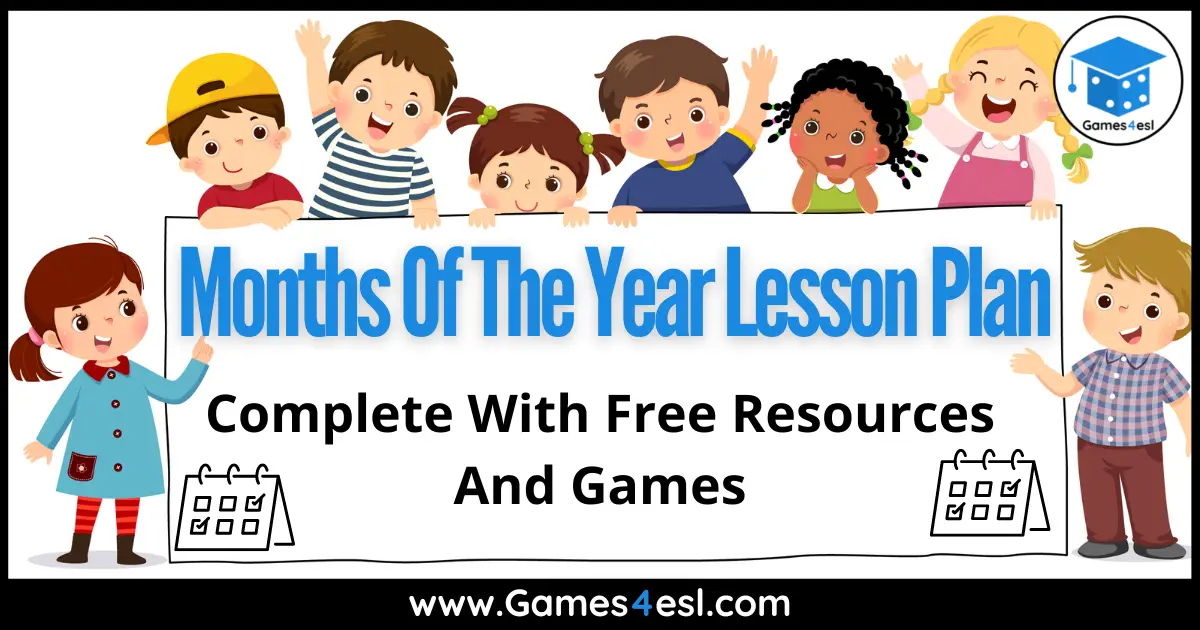Months Lesson Plan
Teaching months of the year? Then this lesson plan is for you! The below lesson plan is ideal for teaching the names of the months in English to kids and beginner English language learners. In this lesson plan, students will sing a song, play fun games, and complete a worksheet while speaking with their classmates. All the resources for this lesson can be downloaded for free below. For even more resources for teaching the months of the year, check the section at the bottom of the page for related resources.
Months Of The Year Lesson Plan
Introduction And Warm-Up
A fun way to start your lesson on months is with a fun months of the year song. A quick search on YouTube will return many ESL songs for teaching months. We particularly like this song by KidsTV123.
First, play the song and ask students to listen and try to guess what they will study today. After listening one time, ask students how many months there are and ask them what months they already know. Then, listen to the song one more time and encourage students to try to sing along.
Next, elicit from students the name of the first month (January). Write this on the board and then ask students what the next month is (February). Continue like this until you have all 12 months written on the board. Finally, play the song again and ask students to sing along as you point to each of the month’s names on the board.
TIP: If students find the song too slow, or you just want to turn the song into a funny activity, try speeding up the song on YouTube and see if the students can keep up.
Practice The Key Expressions
Next, it’s time to practice some more. Point to each of the months of the year and say each month’s name and ask students to repeat after you. Then, ask students to say each month on their own. Once students have practiced enough, it’s time to play a fun game.
Activity 1: What’s Missing?
This first activity is a great way to help students memorize the months of the year. To begin, write all 12 months on the board in order. Then, tell students to close their eyes and put their heads on their desks. Next, erase one of the months from the board. Then, tell students to open their eyes and ask them, “What’s missing?“
Once a student answers correctly, re-write that month on the board and then play again. Keep playing until you have gone through each month of the year.
TIP: If this game is too easy for students, you can make it more challenging by writing out the months of the year in a random order, spaced out across the board. You can also try erasing 2 or 3 months at a time and see if students can guess all of them.
Activity 2: The Four Corners Game
This next activity is a great way to get kids up out of their seats and moving around the class while practicing months of the year. To begin, ask students what the first four months of the year are (January, February, March, April). Next, name each of the 4 corners of the classroom one of these months of the year. Now the game can begin.
Write one of the four months down on a piece of paper or a small whiteboard, and don’t show students. Next, give students 5 seconds to move to one of the four corners of the classroom. After the 5 seconds, reveal which month you wrote down. The students that are at the corresponding corner are out and must sit down.
Then, write down another month and give students 5 seconds to move to a new corner. Continue like this until you only have one student left standing. That student is the winner. After this first game, play again with the next 4 months of the year, and then play a third time with the final 4 months of the year.
TIP: This game can get quite rowdy and so to ensure safety, be sure to remove any bags/coats, etc., off the floor so that students don’t trip, and tell students not to run or push as they move to their chosen corner.
Activity 3: Speaking Activity – When is Your Birthday?

Introducing the topic of birthdays is a fantastic way to practice the names of the months in English. In this next activity, students will ask and answer about each other’s birthday month and complete a worksheet.
To begin, download and print this worksheet and give one to each student. Next, ask each student to find their birthday month and write their name in the corresponding box. Then, teach the students how to ask and answer about someone’s birthday. For example, “When is your birthday?” – “It’s in February.“.
Once students have practiced enough, it’s time to start the speaking activity. Students must stand up, walk around the class, and ask and answer, “When is your birthday.“. Then, they must fill in the worksheet by writing the students’ names in the corresponding boxes. Each student must ask everyone in the class, so by the end of the activity, everyone’s worksheet should have the same answers.
TIP: To get students practicing more, at the end of the activity, you can ask the whole class, “When is Kelly’s Birthday?“, “When is Chris’ birthday?”, etc., and have everyone answer chorally as a class.
Review: Door Check
At the end of the lesson, be sure to review the names of the months with students. A great way to do this is with the door check activity. Have students pack up their bags, push their chairs under their desks, and then line up at the door. Before students leave, ask each one individually a question regarding the months of the year. For example, you can ask them, “When is your birthday?“, or “Which month comes next? January, February, ..?“.
Related Resources
Thanks for reading. I hope your students have lots of fun learning about the months of the year. Here are some more free resources that are not included above that you can use in your next lesson on months in English:
Months Worksheets
Months PowerPoint Lesson
Months Quiz
Printable List Of Months In English


